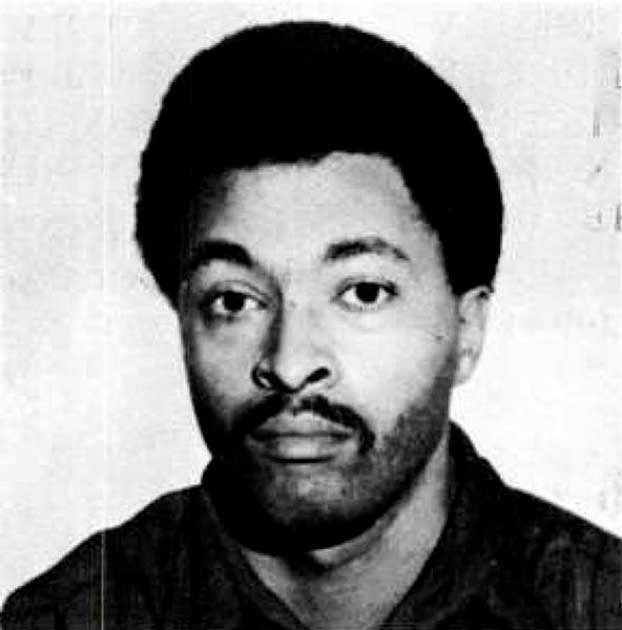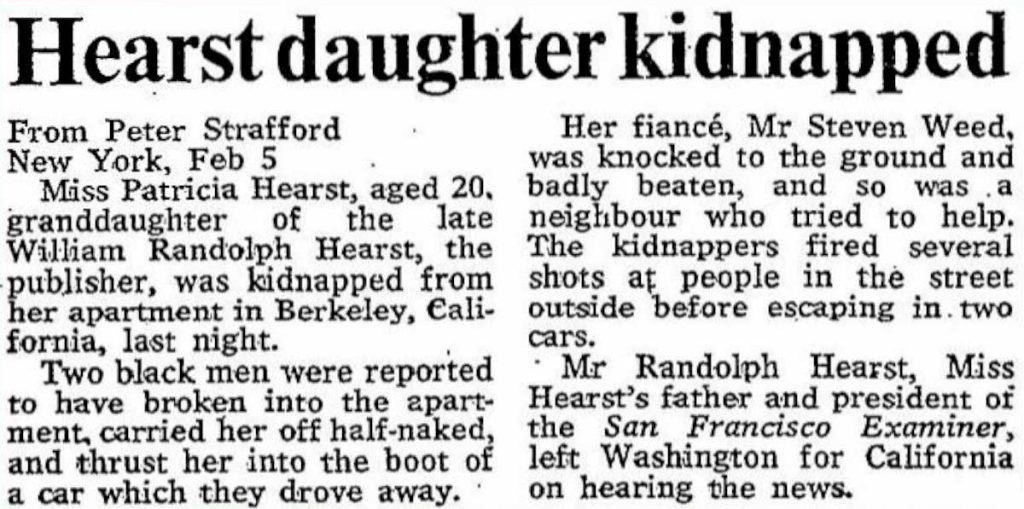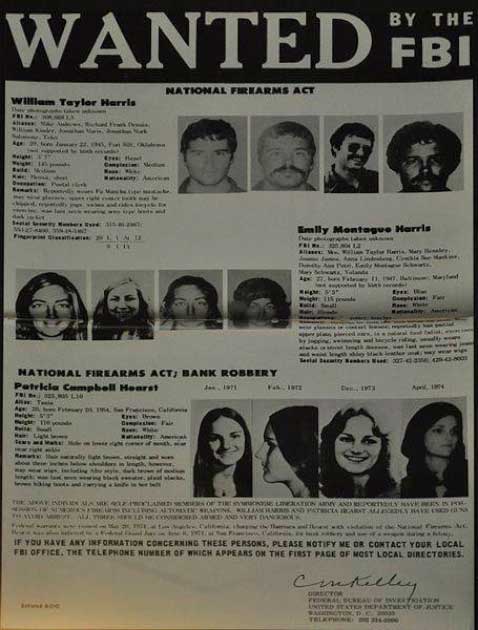It is the 1970s in the United States, and it is a time of change. Political conservatism was growing, and against this the demands for ethnic and sexual equality became louder. All eyes were on Washington DC after The Watergate Scandal and President Nixon’s impeachment.
However, the country paused when news broke about a kidnapped heiress. The story was filled with interesting details and salacious titbits: a radical terrorist organization, her membership in the group, and a string of robberies they performed together. Everyone wanted to know one thing: what side was Patricia Hearst on?
Patricia Campbell Hearst
Patty Hearst was born in San Francisco, California, in 1954, to a very rich family. Her grandfather, William Randolph Hearst, had created the world’s largest movie, magazine, and newspaper businesses. In 1974, Patty was a sophomore at the University of California, Berkeley, engaged and living with her fiancé. Everything was perfect.
However everything changed in February 4, 1974, with a knock at the couple’s front door. A woman said she needed to use a phone, but as the door was opened wider to admit her a group of men and women pushed into the house, armed with guns.
Hearst’s fiancé was beaten, tied up, and left helpless to watch as the group bound, blindfolded, gagged, and threw 19-year-old, Patty into the trunk of a car. She had been kidnapped, but he had absolutely no idea who the kidnappers were, or why the attack had taken place.
The Symbionese Liberation Army (SLA)
The kidnappers were members of a left-wing guerilla group, whom the FBI later identified as a terrorist organization. The organization had grown from some leftist students from University of California, Berkeley, who were pushing for prison reform and would go to prisons and tutor inmates.

It was here that the young, idealistic adults met Donald DeFreeze, an inmate, and listened to the ideas he had. DeFreeze and the students went on to create the “Symbionese Liberation Army” (known as the SLA) when he was transferred from Vacaville Prison to Soledad Prison in California in 1972.
In 1973 DeFreeze escaped from Soledad while on work duty. The SLA became an organization in earnest under DeFreeze, who took the name “Field Marshal Cinque” or Cinque for short. Emboldened by the escape of their leader, two members of the SLA murdered the first black school superintendent of Oakland.
The victim was shot with a cyanide-tipped hollow point bullet because he felt that creating school student I.Ds was a good idea. The two SLA members were arrested and sent to prison for the murder. The SLA needed a captive for leverage, and this is where Patty comes into the story.
A Valuable Captive
Patty Hearst was kidnapped by the group and held in a locked closet blindfolded. During her captivity she would be repeatedly assaulted and raped by her captors, and while the blindfold was never removed she was able to here their rants about their cause.

In truth, the SLA had no sophisticated plan in place, and had chosen Hearst due to her wealthy and politically connected family. They wanted to leverage Patty’s freedom for the release of the SLA members who were in jail.
- Kidnapping and Murder of the Lindbergh Baby
- Seeking Perfection? The Imperfect Crime of Leopold and Loeb
The SLA demanded the Hearst family have their friends released, but that was not something the family could do. The family was then ordered to donate $400 million worth of food to the hungry and poor in the Bay Area.
Her father, Randolph Hearst, donated $2 million, and the food distribution began. It was a disaster; riots occurred at the distribution location, injuring many and leading to multiple arrests.
The SLA then released a tape of Hearst saying, “So far, it sounds like you and your advisors managed to turn it into a real disaster.” The release of the tape let the public know that the girl was still alive, but the next audio tape released from the group shocked the nation. 59 days after she was kidnapped, Hearst is heard to say:
“I have been given the choice of being released… or joining the forces of the Symbionese Liberation Army and fighting for my freedom and the freedom of all repressed people. I have chosen to stay and fight.”
In the tape, Hearst mentioned that her new name was Tania. Tania was the alias of a woman who fought alongside Che Guevara in the Cuban Revolution. On April 15, 1974, just 12 days after the announcement that Hearst joined the SLA, the SLA with Hearst robbed a bank in the Sunset District of San Francisco. On security tapes, she is seen holding a sizeable M1 carbine, a semi-automatic rifle popular in WWII, at the bank’s hostages.
FBI agents released a statement that the other SLA members had guns pointing at Hearst throughout the robbery, but a cropped version of that scene wasn’t shown in a later trial. The robbers managed to escape without capture.
A few weeks later, Hearst was waiting in a van while two other SLA members went to buy/steal ammo from a store. When the clerk chased the two out of the store and started fighting, all hell broke loose.
From the open van window, Hearst began shooting at the store, firing 15 times before driving off with the other two members. Before they could be notified, the LAPD sent their SWAT team to the SLA house and were met with gunshots. The world saw this battle between six SLA members in the home and the LAPD on national television.
Ultimately the LAPD lost control of the situation and the house caught on fire, killing all inside. It was assumed that Hearst died in the home, but this was not the case. Hearst and two other SLA members who had avoided being killed spent the next 15 months on the run. They robbed another bank, an attack which led cops to the three fugitives. Hearst was finally captured and arrested in San Francisco in 1975.
Brainwashed?
When arrested, Hearst weighed only 87 pounds (40kg), and a psychologist who assessed her said she behaved like a low-IQ zombie. A record of her condition and any trauma experienced was recorded. Her IQ was reassessed at 112, while before the kidnapping, it was 130. She couldn’t remember things about her life pre-kidnapping. She was having trouble sleeping and began to smoke almost constantly, all indications of trauma.

However, this did little to help her at trial. Here, it was decided that the tapes, letters she wrote, and any actions after the first bank robbery were evidence of her being an active and willing member of the SLA. She was said to be acting of her own free will and sentenced to seven years in prison.
However, U.S. President Jimmy Carter commuted Hearst’s sentence down to 22 months served. Patty was released from prison on February 1, 1979. Now a free woman, Patty wrote a book about the experience and was active in many charities and community programs.
The crimes she had committed stayed with her for decades. Only on then-President Bill Clinton’s last day in office, was Patty Hearst pardoned. She was granted her civil rights entirely in 2001.
Was this draconian punishment justified? On the one hand, she had clearly participated in serious crimes, threatening innocent bystanders with a gun. On the other, Hearst said that she stayed because she was afraid they would kill her if she left or disobeyed her captives.
The group made her feel like her family didn’t want her back, telling her they were only willing to donate $2 million rather than the full $400 million. They obviously did want her back, however in this drip-feed of information we find the core of how Patty was broken by the SLA.

Brainwashing or coercive persuasion was not a common thing in the legal system, but it was known. Senator Leo Ryan had gathered signatures for her release, believing her to have acted under duress, before he himself he was killed in the run up to the Jonestown massacre in Guyana.
This massacre, and the mass suicide that killed 900 members of the Peoples Temple cult, put Patty Hearst’s actions in a new light. Arguments were made that if all those people were brainwashed to all participate in a mass suicide by “drinking the Kool-Aid,” it was entirely possible that Patty was brainwashed too.
The phenomenon even has a name: Stockholm Syndrome is when victims form a psychological bond with their captives. With Stockholm Syndrome, a victim will develop positive emotions toward their captor. They even refuse to work with the police to send the captor to prison. The syndrome develops when a captor starts to act kindly towards the hostage.
The process is well mapped, and even deliberately employed. The hostage will have spent several days (or longer) enduring abuse, confinement, sleep deprivation and starvation from their captor. Then the captor will do something “nice” like letting the victim have the ability to roam around unbound, give food and other items. The victim feels that the captor is not “so bad” or that they are doing this to care for the victim.
At the time of the Hearst trial, Stockholm Syndrome was a very new concept. The robbery and hostage event in Stockholm, Sweden, where the syndrome gets its name, occurred in 1973. Patty Hearst was convicted in the United States in 1976, where Stockholm Syndrome was not widely recognized.
And it remains controversial, to be sure. Today, the Diagnostic and Statistical Manual of Mental Disorders 5 (DSM5) has not included Stockholm Syndrome in its list of illnesses. There hasn’t been enough solid and scientifically assessed research on the syndrome. From a psychological viewpoint, it may be a thing, but it’s not something that can be diagnosed.
Was she brainwashed, or did she willingly join the SLA? There is plenty of evidence of her mistreatment by the criminals who kidnapped her. But as to whether she joined them willingly, or whether she was broken by them, only Patty can say for sure.
Top Image: Patty Hearst’s arrest photo, and Hearst as an armed bank robber at the Hibernia Bank. Source: Unknown Author / Public Domain; Closed Circuit Security Camera / Public Domain.
By Lauren Dillon